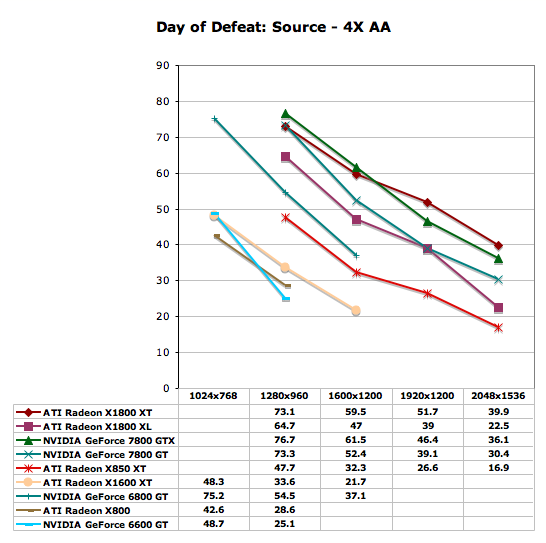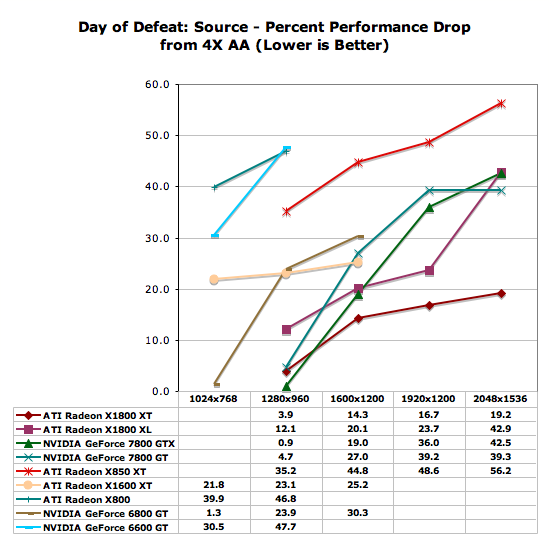ATI's X1000 Series: Extended Performance Testing
by Derek Wilson on October 7, 2005 10:15 AM EST- Posted in
- GPUs
Day of Defeat: Source Performance
Rather than test Half-Life 2 once again, we decided to use a game that pushed the engine further. The reworked Day of Defeat: Source takes 4 levels from the original game and adds not only the same brush up given to Counter Strike: Source, but HDR capabilities as well. The new Source engine supports games with and without HDR. The ability to use HDR is dependent on whether or not the art assets needed to do the job are available.
In order to push this test to the max, the highest settings possible were tested. This includes enabling the reflect all and full HDR options. Our first test was run with no antialiasing and trilinear filtering, and our second set of numbers was generated after 4x antialiasing and 8x anisotropic filtering were enabled.
From the looks of our graph, we hit a pretty hard CPU barrier near 80 frames per second. The 7800 GTX sticks the closest to this limit for the longest, but still can't help but fall off when pushing two to three megapixel resolutions. The 7800 GT manages to out-perform the X1800 XT, but more interestingly, the X850 XT and X1800 XL put up nearly identical numbers in this test. The X1300 Pro and the X1600 XT parallel each other as well, with the X1600 XT giving almost the same numbers as the X1300 Pro one resolution higher. The 6600 GT (and thus the 6800 GT as well) out-performs the X1600 XT pretty well.

Antialiasing changes the performance trends a bit, but at lower resolutions, we still see our higher end parts reaching up towards that 80 fps CPU limit. The biggest difference that we see here is that the X1000 series are able to gain the lead in some cases as resolution increases with AA enabled. The X1800 XT takes the lead from the 7800 GTX at 1920x1200 and at 2048x1536. The 7800 GT manages to hold its lead over the X1800 XL, but neither is playable at the highest resolution with 4xAA/8xAF enabled. The 6600 GT and X1600 XT manage to stop being playable at anything over 1024x768 with AA enabled. On those parts, gamers are better off just increasing the resolution to 1280x960 with no AA.

The 7800 series parts try to pretend that they scale as well as the X1800 series at 1600x1200 and below when enabling AA. The X850 XT scales worse than the rest of the high end, but this time, the X1600 XT is able to show that it handles the move to AA better than either of the X8xx parts test and better than the 6600 GT as well. The 6800 GT takes the hit from antialiasing better than the X1600 XT though.

Doom 3 showed NVIDIA hardware leading at every step of the way in our previous tests. Does anything change when looking at numbers with and without AA enabled?
Rather than test Half-Life 2 once again, we decided to use a game that pushed the engine further. The reworked Day of Defeat: Source takes 4 levels from the original game and adds not only the same brush up given to Counter Strike: Source, but HDR capabilities as well. The new Source engine supports games with and without HDR. The ability to use HDR is dependent on whether or not the art assets needed to do the job are available.
In order to push this test to the max, the highest settings possible were tested. This includes enabling the reflect all and full HDR options. Our first test was run with no antialiasing and trilinear filtering, and our second set of numbers was generated after 4x antialiasing and 8x anisotropic filtering were enabled.
From the looks of our graph, we hit a pretty hard CPU barrier near 80 frames per second. The 7800 GTX sticks the closest to this limit for the longest, but still can't help but fall off when pushing two to three megapixel resolutions. The 7800 GT manages to out-perform the X1800 XT, but more interestingly, the X850 XT and X1800 XL put up nearly identical numbers in this test. The X1300 Pro and the X1600 XT parallel each other as well, with the X1600 XT giving almost the same numbers as the X1300 Pro one resolution higher. The 6600 GT (and thus the 6800 GT as well) out-performs the X1600 XT pretty well.

Antialiasing changes the performance trends a bit, but at lower resolutions, we still see our higher end parts reaching up towards that 80 fps CPU limit. The biggest difference that we see here is that the X1000 series are able to gain the lead in some cases as resolution increases with AA enabled. The X1800 XT takes the lead from the 7800 GTX at 1920x1200 and at 2048x1536. The 7800 GT manages to hold its lead over the X1800 XL, but neither is playable at the highest resolution with 4xAA/8xAF enabled. The 6600 GT and X1600 XT manage to stop being playable at anything over 1024x768 with AA enabled. On those parts, gamers are better off just increasing the resolution to 1280x960 with no AA.

The 7800 series parts try to pretend that they scale as well as the X1800 series at 1600x1200 and below when enabling AA. The X850 XT scales worse than the rest of the high end, but this time, the X1600 XT is able to show that it handles the move to AA better than either of the X8xx parts test and better than the 6600 GT as well. The 6800 GT takes the hit from antialiasing better than the X1600 XT though.

Doom 3 showed NVIDIA hardware leading at every step of the way in our previous tests. Does anything change when looking at numbers with and without AA enabled?










93 Comments
View All Comments
Spacecomber - Friday, October 7, 2005 - link
I think that the 6600GT is a bit faster than the 9800 Pro, but essentially in the same league. HTHSpace
Peldor - Friday, October 7, 2005 - link
The closest card to a 9800 Pro in these reviews is the 6600GT. Generally the 6600GT will be a bit faster than the 9800Pro, but not huge (except in OpenGL).Spacecomber - Friday, October 7, 2005 - link
Oops, didn't mean to be redundant. I guess I took to long to post my comment.